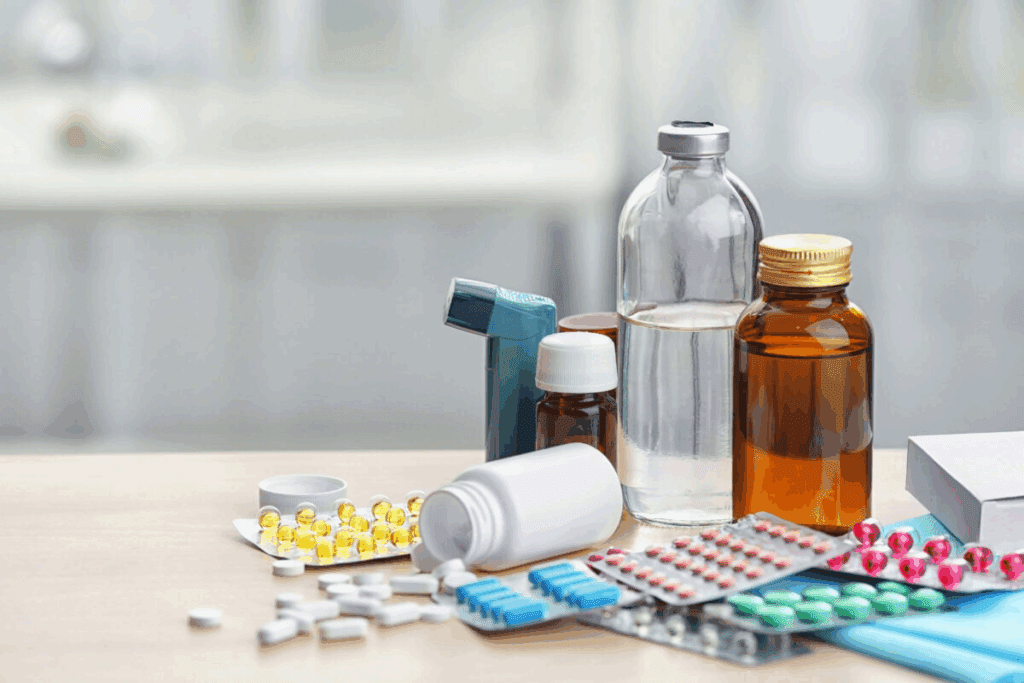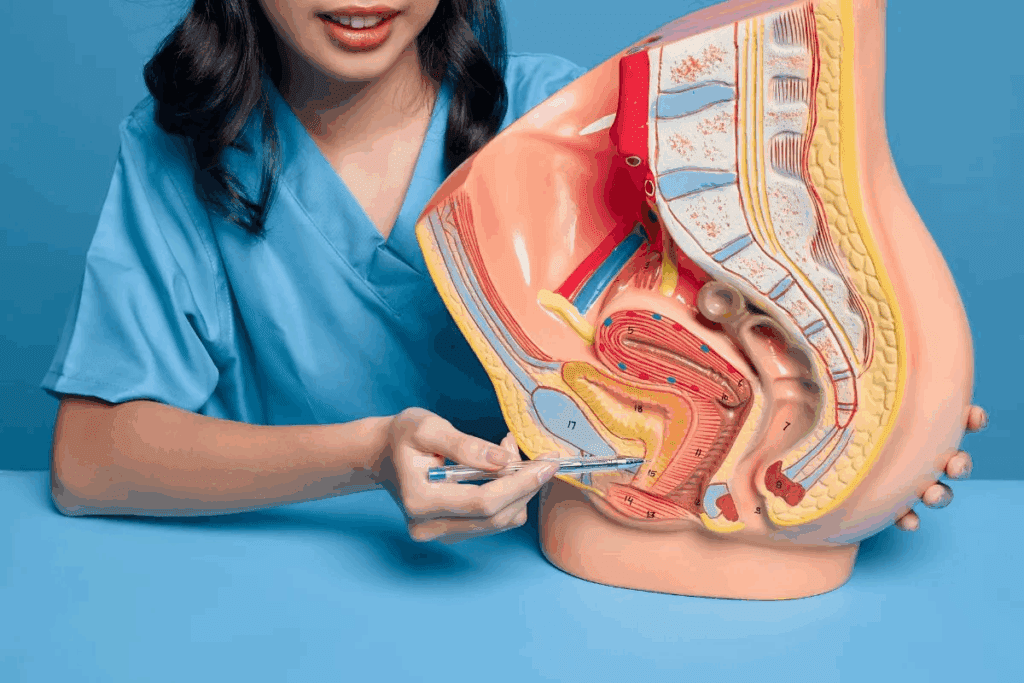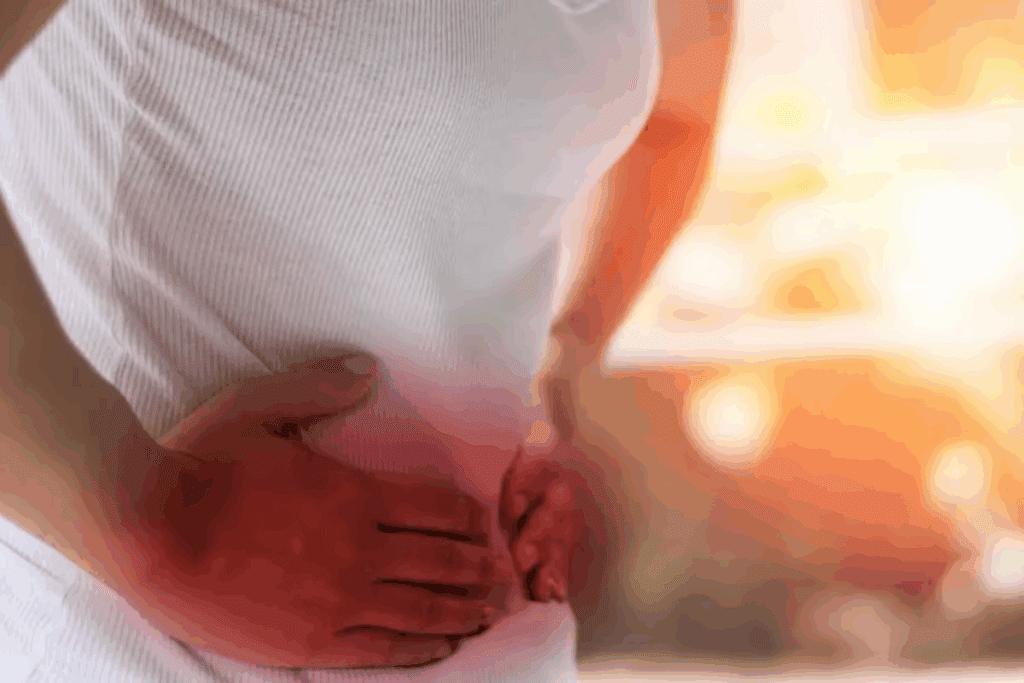Last Updated on November 25, 2025 by Ugurkan Demir

Urinary incontinence is a big health issue that affects millions worldwide. It greatly impacts their quality of life. We will look at the top 15 medications for treating urinary incontinence and overactive bladder. A complete list of 15 effective drugs for urinary incontinence. Explore all the medication options for better bladder control.
The global market for urinary incontinence treatments was about $4.37 billion in 2023. It’s expected to grow at a 4.0 percent annual rate from 2024 to 2030. This growth is because more people have overactive bladder and the population is getting older.

It’s important to understand urinary incontinence to manage its effects. This condition affects both physical and emotional health. It’s not just a medical issue but a big change in life.
Urinary incontinence has several types, each with its own features. The main types are stress incontinence, urge incontinence, and mixed incontinence.
Urinary incontinence is more common in women than men. It gets more common with age, affecting many elderly people. It impacts their physical health, emotional well-being, and social life.
| Demographic | Prevalence of Urinary Incontinence | Impact on Quality of Life |
| Women | Higher prevalence compared to men | Significant emotional and social impact |
| Elderly | Increased prevalence with age | Often results in social isolation and decreased mobility |
| Men | Lower prevalence compared to women | Significant impact on daily activities and emotional well-being |
We know that managing urinary incontinence can greatly improve a person’s life. This includes using drugs for bladder control and making lifestyle changes. Behavioral therapies also play a big role.

Drugs for urinary incontinence target the bladder muscle and the nerves that control it. They aim to relax the bladder muscle or improve bladder control. This helps reduce symptoms of urinary incontinence.
The bladder’s ability to store urine is complex. It involves the bladder muscle (detrusor) and the nervous system. Anticholinergic medications, like oxybutynin and tolterodine, help by reducing bladder muscle contractions. This makes it easier to hold urine and reduces urgency.
The main parts of bladder control include:
Drugs for urinary incontinence work in different ways. Beta-3 adrenergic agonists, such as mirabegron, relax the bladder muscle. This increases bladder capacity and reduces how often you need to urinate. Knowing how these drugs work helps choose the best treatment.
The main action pathways are:
Understanding how these drugs work helps doctors create personalized treatment plans. This addresses the specific needs of patients with urinary incontinence.
Anticholinergic drugs are often the first choice for treating urinary incontinence. They work by blocking the action of acetylcholine at muscarinic receptors in the bladder. This helps reduce bladder contractions and improves control.
These drugs are great for treating overactive bladder and urge incontinence. They block acetylcholine at muscarinic receptors in the bladder. This action reduces bladder contractions and improves control.
Oxybutynin is a well-known drug for urinary incontinence. It comes in immediate-release and extended-release forms. The immediate-release form is taken several times a day, while the extended-release form is taken once daily.
Key Benefits: It reduces urinary frequency and urgency. It’s available in multiple forms.
Tolterodine is another effective drug for urinary incontinence. It’s known for being selective to the bladder. This may reduce side effects compared to other drugs.
“Tolterodine has been demonstrated to significantly reduce urinary frequency and urgency in patients with overactive bladder.”
Solifenacin is a newer drug with improved tolerability and efficacy. It’s taken once daily and has shown to be effective in reducing urinary incontinence symptoms.
Key Benefits: It’s taken once daily. It’s effective in reducing urinary incontinence symptoms.
Fesoterodine is another effective drug for urinary incontinence. It’s available in extended-release formulations. This makes it convenient for patients.
| Medication | Formulation | Dosing Frequency |
| Oxybutynin (Ditropan) | Immediate-Release, Extended-Release | Multiple times a day, Once daily |
| Tolterodine (Detrol) | Immediate-Release, Extended-Release | Twice a day, Once daily |
| Solifenacin (VESIcare) | Once daily tablet | Once daily |
| Fesoterodine (Toviaz) | Extended-Release | Once daily |
In conclusion, drugs like oxybutynin, tolterodine, solifenacin, and fesoterodine are effective for urinary incontinence. Each drug has its own benefits. Healthcare providers can choose the best treatment for each patient.
Other anticholinergic medications can help with urinary incontinence. They are good for those who don’t get better with the first treatments. Or for those who need more choices.
Trospium doesn’t cross the blood-brain barrier. This might lower the risk of brain side effects. It’s a good choice for older patients or those worried about brain effects. Clinical studies show Trospium helps with overactive bladder symptoms, like urgency and needing to go often.
Darifenacin targets the M3 muscarinic receptor mainly. This might reduce side effects from other medications. Darifenacin can lessen bladder overactivity and might have fewer side effects.
Propiverine works as an anticholinergic and calcium channel blocker. It’s for those who don’t get better with usual treatments. Its unique action helps relax the bladder muscle. Propiverine is great for complex bladder control issues.
These extra medications give doctors more ways to treat urinary incontinence. Knowing each medication’s benefits helps doctors create better treatment plans for their patients.
Talking about side effects and benefits with a healthcare provider is key. They can help choose the best treatment for you.
Extended-release medications are a big step forward in treating urinary incontinence. They help patients stick to their treatment and lessen side effects of regular medications.
Managing urinary incontinence needs a variety of approaches. New extended-release versions of anticholinergic drugs aim to solve problems with the old ones.
Oxybutynin extended-release, or Ditropan XL, is a better choice than the immediate-release version. It slowly releases the active ingredient, keeping levels steady and reducing side effects.
Key benefits of oxybutynin extended-release include:
Tolterodine extended-release, or Detrol LA, is another promising option for urinary incontinence. Like oxybutynin extended-release, Detrol LA offers sustained release and better tolerability.
The advantages of tolterodine extended-release include:
To show the benefits of these extended-release drugs, let’s compare them in a table:
| Medication | Dosing Frequency | Common Side Effects |
| Oxybutynin Extended-Release (Ditropan XL) | Once daily | Dry mouth, constipation |
| Tolterodine Extended-Release (Detrol LA) | Once daily | Dry mouth, headache |
Medical Expert, a urologist, says, “Extended-release drugs have changed the game for urinary incontinence. They offer patients a better, more effective treatment.”
“The development of extended-release anticholinergics has significantly improved our ability to manage urinary incontinence, providing patients with better symptom control and improved quality of life.”
In conclusion, extended-release drugs like oxybutynin and tolterodine are a big step forward in treating urinary incontinence. They provide long-lasting relief and fewer side effects, improving patient outcomes and quality of life.
Beta-3 adrenergic agonists are new treatments for overactive bladder. They relax the bladder muscle, increasing its capacity. This reduces how often you need to go to the bathroom.
Mirabegron was the first drug of its kind for overactive bladder. It helps lessen urgency, frequency, and incontinence. Studies show it’s safe and effective, making it a good choice for many.
Vibegron is another drug for overactive bladder. It works like Mirabegron, giving patients another option. Its approval has widened the treatment options for overactive bladder.
Beta-3 adrenergic agonists, like Mirabegron and Vibegron, have benefits. They have fewer side effects than some other drugs. This makes them a good choice for those who can’t take other medications.
Some key advantages of beta-3 adrenergic agonists include:
Beta-3 adrenergic agonists are a big step forward in treating overactive bladder. Their unique action and fewer side effects make them a valuable option for both patients and doctors.
Topical and transdermal medications are a new way to manage urinary incontinence. They avoid the stomach, which can reduce side effects like dry mouth and constipation. We’ll look at two key options: the oxybutynin transdermal patch (Oxytrol) and oxybutynin gel (Gelnique).
The oxybutynin transdermal patch, or Oxytrol, releases oxybutynin through the skin into the blood. This steady release helps keep the medication levels right, making it easier for patients to stick to their treatment. The patch is great because it cuts down on stomach side effects, which many people find appealing.
Oxybutynin gel, or Gelnique, is another topical treatment for urinary incontinence. The gel is applied to the skin and absorbed into the blood. It’s flexible and easy to use, fitting different patient needs. The gel helps reduce incontinence symptoms and may lower the chance of systemic side effects.
Both the oxybutynin transdermal patch and gel are big steps forward in treating urinary incontinence. They offer new ways to take medication, making it easier for patients to manage their condition. These options are part of a bladder control drugs list, helping those with incontinence find relief.
When looking at drugs for bladder control, talking to a doctor is key. They can help pick the best treatment. Topical and transdermal options like Oxytrol and Gelnique are important in the incontinence medication list. They give patients choices that fit their needs.
When standard treatments don’t work, alternative medications can help manage urinary incontinence. These options are key for those who haven’t found relief yet.
Urinary incontinence is complex and needs a variety of treatments. For some, alternative meds might be the answer to better bladder control.
Tricyclic antidepressants, like imipramine, are used off-label for urinary incontinence. They’re helpful for those with both depression and incontinence.
Imipramine relaxes the bladder muscle and increases bladder capacity. This reduces incontinence episodes. But, it’s important to consider side effects like dry mouth and dizziness.
Desmopressin is mainly for bedwetting but can help with urinary incontinence too. It reduces urine production, lowering the chance of incontinence.
It’s great for patients with frequent nighttime urination. Desmopressin improves sleep quality by reducing urine production.
Duloxetine, a serotonin-norepinephrine reuptake inhibitor, helps stress urinary incontinence in women. It strengthens the urethral sphincter, improving bladder control.
Duloxetine is for those with stress urinary incontinence who haven’t found relief elsewhere. It can greatly improve their quality of life.
In conclusion, options like tricyclic antidepressants, desmopressin, and duloxetine offer valuable treatments for urinary incontinence. We must carefully consider their benefits and side effects to best care for our patients.
Advanced treatments offer new hope for those with severe urinary incontinence. These treatments are for those who haven’t seen relief from usual medications. Healthcare providers look at other options that target the root causes of incontinence.
Botulinum Toxin, or Botox, is used for overactive bladder and incontinence. Injecting Botox into the bladder muscle can greatly reduce symptoms of urgency and frequency. This is for those who haven’t gotten better with usual treatments.
The injections relax the bladder muscle. This increases bladder capacity and lessens the urge to urinate.
For postmenopausal women, estrogen therapy is an advanced treatment for incontinence. Vaginal estrogen helps improve urethral closure and bladder symptoms. Low-dose vaginal estrogen therapy is given through creams, rings, or tablets.
This treatment is great for women with vaginal atrophy and incontinence. It provides localized relief with little systemic absorption.
These advanced treatments are big steps forward in managing severe urinary incontinence. By knowing these options, patients and healthcare providers can find the best treatment plan for each person.
When looking at drugs for urinary incontinence, knowing the side effects is key. These drugs can have effects that impact your health. It’s important to understand these to manage your incontinence well.
Many incontinence medication list items, like anticholinergic drugs, can cause side effects. These include dry mouth, constipation, and problems with thinking. For example, oxybutynin and tolterodine can dry out your mouth.
Some people might face more serious side effects, like confusion or memory loss. This can happen with higher doses or when taking more than one drug. Always talk to your doctor about any side effects you have.
Elderly patients need special care when taking bladder control medication list items. They might be more sensitive to side effects and have other health issues. This means they might need different doses or treatments.
It’s vital for elderly patients to see their doctors regularly. This helps make sure the treatment is working and safe. It also allows for any needed changes to the treatment plan.
Understanding drug interactions and contraindications is also important. Some drugs can interact with incontinence medications, causing problems. For example, mixing anticholinergic drugs can increase side effects.
Tell your doctor about all the medications you’re taking. This includes over-the-counter drugs and supplements. Some medical conditions might mean you can’t take certain incontinence medication list items. A thorough medical check before starting treatment is essential.
Finding the right medication for urinary incontinence is key. We’ve looked at different drugs for bladder control. These include anticholinergic medications, beta-3 adrenergic agonists, and other options. Each has its own way of working and side effects.
The right medication depends on the type of incontinence and the patient’s health. Knowing about the different types and how medications work helps doctors and patients choose the best treatment.
Having a complete bladder control drugs list is vital for making treatment choices. The right medication can help people with urinary incontinence feel better and live better lives. It’s important for doctors and patients to work together to find the best treatment.
The main types are stress, urge, and mixed incontinence. Stress incontinence happens when movement or pressure on the bladder causes leaks. This often occurs during coughing, sneezing, or exercising.
Urge incontinence is when you suddenly feel a strong need to urinate, leading to leaks. Mixed incontinence is a mix of both stress and urge incontinence.
These medications, like oxybutynin and tolterodine, block acetylcholine at muscarinic receptors in the bladder. This action reduces bladder contractions. It also decreases how often you need to urinate and feel the urge to do so.
Side effects include dry mouth, constipation, and problems with thinking. Older adults might be more likely to experience these issues.
Beta-3 adrenergic agonists, such as mirabegron and vibegron, relax the bladder muscle during storage. This increases bladder capacity and reduces how often you need to urinate. They’re an option for those who can’t take anticholinergic medications.
Yes, there are alternatives. Tricyclic antidepressants like imipramine can help. Desmopressin is used for nighttime wetting. Duloxetine is an option for stress urinary incontinence in women.
Advanced treatments include Botox injections into the bladder muscle. Estrogen therapy, like vaginal estrogen, can also help. It improves urethral closure and bladder symptoms in postmenopausal women.
To manage side effects, know what they are and watch for them. Adjust your treatment as needed. Always follow the dosage and talk to your doctor if side effects bother you.
Elderly patients can take these medications, but with caution. They might be more sensitive to side effects and have other health issues. Doctors need to weigh the risks and benefits carefully.
Extended-release formulas, like oxybutynin extended-release (Ditropan XL) and tolterodine extended-release (Detrol LA), make it easier to stick to treatment. They release the active ingredient slowly, keeping levels steady and reducing side effects.
Yes, there are topical and transdermal options, like the oxybutynin transdermal patch (Oxytrol) and oxybutynin gel (Gelnique). They’re convenient and might be safer, avoiding the stomach and reducing side effects.
Finding the right medication involves working closely with your doctor. They’ll help choose the best treatment based on your condition, medical history, and how medications work.
National Center for Biotechnology Information. (2025). 15 Drugs for Urinary Incontinence Complete Bladder Control. Retrieved from https://www.ncbi.nlm.nih.gov/pmc/articles/PMC8630428/
Subscribe to our e-newsletter to stay informed about the latest innovations in the world of health and exclusive offers!